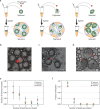Polyhedral Particles with Controlled Concavity by Indentation Templating
- PMID: 35578791
- PMCID: PMC9161221
- DOI: 10.1021/acs.analchem.1c04884
Polyhedral Particles with Controlled Concavity by Indentation Templating
Abstract
Current methods for fabricating microparticles offer limited control over size and shape. Here, we demonstrate a droplet microfluidic method to form polyhedral microparticles with controlled concavity. By manipulating Laplace pressure, buoyancy, and particle rheology, we generate microparticles with diverse shapes and curvatures. Additionally, we demonstrate the particles provide increased capture efficiency when used for particle-templated emulsification. Our approach enables microparticles with enhanced chemical and biological functionality.
Conflict of interest statement
The authors declare no competing financial interest.
Figures





References
Publication types
MeSH terms
Grants and funding
LinkOut - more resources
Full Text Sources
Other Literature Sources

